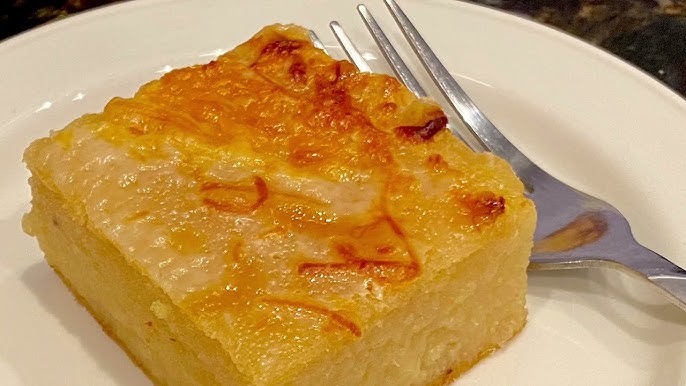Bake Cassava Cake Recipe: Cassava cake is one of those desserts that immediately brings warmth and nostalgia, especially if you’ve ever grown up in or around Southeast Asian cultures. Most notably enjoyed in the Philippines, this moist, creamy, and chewy cake is a staple at family gatherings, fiestas, and special occasions. Whether you’re trying it for the first time or recreating it to reconnect with your roots, baking cassava cake at home is easier than you think—and the result is worth every bite.
What makes cassava cake so loved? It’s the perfect mix of sweet and savory. The richness of coconut milk and condensed milk, paired with the chewy texture of grated cassava, creates a dessert that’s hard to resist. You can also top it with creamy custard or a generous sprinkle of cheese for that extra flavor kick. In this step-by-step guide, you’ll learn everything—from selecting the right ingredients to baking the perfect golden top layer. So tie on your apron and get ready to make one of the most comforting treats in Asian cuisine!
Ingredients You’ll Need
Getting your ingredients right is crucial to nailing the perfect cassava cake. Let’s break it down so you know exactly what to grab before heading into the kitchen.
Main Ingredients:
- 2 pounds grated cassava (fresh or frozen)
- 1 can (14 oz) sweetened condensed milk
- 1 can (12 oz) evaporated milk
- 1 can (14 oz) coconut milk
- 3/4 cup granulated sugar (adjust to your preferred sweetness)
- 2 large eggs
- 1/4 cup melted butter (unsalted preferred)
- 1 tsp vanilla extract
Optional Toppings:
- 1/2 cup grated cheese (cheddar works great for contrast)
- 1/2 cup macapuno (optional but adds chewy sweetness)
- Latik (coconut curds) for an authentic Filipino twist
These ingredients are relatively easy to find at any Asian grocery store or international aisle. If you’re using frozen cassava, make sure to fully thaw it before using.
Kitchen Tools You’ll Need
Before diving into the actual process, it helps to make sure your kitchen is armed with the right tools. Cassava cake is a simple dessert but having the correct equipment makes the process smoother.
- Mixing bowls – at least two, for dry and wet mixtures
- Measuring cups and spoons – precision matters in baking
- Whisk or electric hand mixer – to beat your eggs and mix your batter
- Grater – if you’re working with fresh cassava
- Baking pan – an 8×8 inch or 9×13 inch pan works great
- Spatula – to spread the batter evenly
- Aluminum foil – optional, to avoid over-browning
- Oven – for that golden-baked finish
Having these on hand not only streamlines the process but helps ensure your cassava cake bakes evenly and turns out perfect every time.
Choosing Between Fresh and Frozen Cassava
Not sure whether to use fresh or frozen cassava? Here’s a quick breakdown to help you decide.
Fresh Cassava:
- Pros: More natural taste, better texture, often richer in flavor
- Cons: Requires peeling, grating, and careful prep (cassava contains natural toxins when raw)
Frozen Cassava:
- Pros: Convenient, ready to use, safe and pre-cleaned
- Cons: Slightly less fresh in flavor, may contain more moisture
For beginners, frozen cassava is the safer and quicker route. It’s widely available in most Asian grocery stores and saves you a ton of prep time.
Safety Tips When Handling Cassava
If you’re adventurous and going with fresh cassava, safety is key. Cassava contains naturally occurring cyanogenic glycosides, which can release cyanide if not properly prepared. But don’t worry—this only becomes an issue if cassava is consumed raw and in large quantities.
Here’s how to safely prepare it:
- Always peel cassava completely. The toxins are concentrated near the skin.
- Soak peeled cassava in water for a few hours to help remove any residual toxins.
- Cook thoroughly. Heat breaks down any remaining harmful compounds.
Stick with frozen if you’re unsure. It’s processed in a way that makes it completely safe and ready to use.
Step-by-Step Guide to Bake Cassava Cake
Let’s get into the fun part: baking the cassava cake! Follow these steps carefully, and you’ll have a moist, rich dessert that tastes just like what Lola (grandma) used to make.
Step 1: Preheat Your Oven
Before anything else, preheat your oven to 350°F (175°C). This ensures even baking once your batter is ready. Skipping this step can result in uneven cooking—something you definitely don’t want with cassava cake.
Step 2: Prepare the Baking Pan
Grease your baking pan with a thin layer of butter or line it with parchment paper. This prevents sticking and makes for easy slicing and serving later.
Pro Tip: You can use a 9×13-inch pan for a thinner cake or an 8×8-inch for a thicker, chunkier slice.
Step 3: Mix the Wet Ingredients
In a large mixing bowl, whisk together the following:
- 2 eggs
- 1 can sweetened condensed milk
- 1 can evaporated milk
- 1 can coconut milk
- 1/4 cup melted butter
- 1 tsp vanilla extract
Whisk until smooth. You want a uniform mixture where everything is blended well. This will serve as the rich, creamy base that defines your cassava cake’s flavor.
Step 4: Add Grated Cassava and Sugar
Now gently fold in:
- 2 lbs grated cassava
- 3/4 cup sugar (adjust depending on your preference)
Stir gently but thoroughly until the grated cassava is fully incorporated into the wet mixture. The batter will be slightly thick—that’s exactly what you want.
Step 5: Blend Until Smooth and Even
If you prefer a smoother consistency, you can blend the mixture for 30 seconds using an electric mixer. But don’t overdo it. A bit of texture is part of what makes cassava cake so delightful.
Step 6: Pour into the Baking Pan
Carefully pour your cassava mixture into the prepared baking pan. Use a spatula to smooth the top and make sure it’s even. This helps the cake cook uniformly and gives it a clean finish.
Step 7: Bake the Base Layer
Pop the pan into your preheated oven and bake for 45 to 50 minutes. The cake should start to set and turn golden on the edges.
You’ll know it’s ready for the topping when the center is mostly firm but still slightly jiggly.
Step 8: Prepare the Topping
While the base bakes, prepare your topping mix:
- 1/2 can condensed milk
- 1/2 can coconut milk
- 1 egg
- Optional: shredded cheese or macapuno
Mix them well in a bowl. This topping adds a creamy, custard-like finish that takes the cassava cake to another level.
Step 9: Add the Topping and Bake Again
Remove the partially baked cassava cake from the oven. Gently pour the topping mixture over it, smoothing it out evenly. Return the cake to the oven and bake for an additional 20 to 25 minutes or until the top is golden brown.
You can broil it for the last 3–5 minutes for a toasted top—but watch it closely so it doesn’t burn!
Step 10: Cool and Slice
Let your cassava cake cool for at least 30 minutes before slicing. This helps it set and makes slicing easier. It can be served warm or cold, depending on your preference.
Serve with a hot cup of coffee or tea, and watch it disappear in minutes!
Tips for the Best Cassava Cake
Want to make your cassava cake stand out from the rest? Here are some tried-and-true tips to help you create a bakery-worthy dessert that’ll have everyone asking for seconds (and the recipe).
Don’t Overbake It
Overbaking is one of the most common mistakes that lead to dry and rubbery cassava cake. Always check your cake around the 45-minute mark for doneness. A slight jiggle in the center is okay—remember, it will continue to set as it cools. If the edges start to brown too much, loosely cover with foil to prevent burning while the center finishes cooking.
Balance the Sweetness
Cassava cake is meant to be sweet, but not cloyingly so. Adjust the amount of sugar depending on your personal taste and whether your toppings are also sweet (like macapuno or sweetened cheese). You can even replace part of the condensed milk with more coconut milk if you want a more mellow sweetness.
Don’t Skip the Topping
That creamy, golden layer on top? It’s what transforms a basic cassava bake into a true cassava cake. The topping adds richness, creaminess, and visual appeal. Broiling it at the end can also give it a beautiful caramelized crust that’s simply irresistible.
Use Room Temperature Ingredients
Cold eggs and milk can affect the consistency of your batter. Let them sit out for a bit before mixing. This ensures everything blends smoothly and evenly.
Let it Rest
Cassava cake tastes even better the next day. Allowing it to chill in the fridge overnight intensifies the flavors and firms up the texture, making for perfect slices every time.
How to Customize Your Cassava Cake
Cassava cake is wonderfully flexible. Think of it as a canvas for your culinary creativity. Once you’ve mastered the basic recipe, you can tweak it in countless ways to suit your taste or add a little flair.
Add Cheese
A layer of grated cheddar or quick-melt cheese on top adds a savory, salty contrast to the sweetness of the cake. It’s a Filipino favorite, and for good reason!
Add Coconut Strings or Macapuno
For added texture and sweetness, mix in some macapuno or sweetened coconut strips into the batter. It gives each bite a chewy surprise that complements the soft cassava.
Adjust the Milk Ratios
Want it creamier? Increase the coconut milk. Prefer a firmer texture? Cut down on the evaporated milk. Play with the ratios to find your perfect version.
Make it Less Sweet
You can reduce the condensed milk or sugar if you prefer a less sweet cake. Just be mindful that cutting too much sugar can affect texture and browning.
Spice It Up
Add a pinch of cinnamon, nutmeg, or even a drop of pandan or ube extract for an exotic twist.
Cassava cake is very forgiving. Try a few of these customizations and you’ll discover your own signature version.
Storage and Shelf Life
Cassava cake keeps surprisingly well, making it perfect for make-ahead desserts or party prep. Here’s how to store it like a pro:
Refrigerator Storage
Let the cake cool completely, then store it in an airtight container or tightly wrap the pan in plastic wrap. It will stay fresh in the refrigerator for up to 5 days.
Freezer Storage
Want to keep it longer? Cassava cake freezes well. Slice it into portions, wrap each piece in plastic wrap, and place them in a freezer-safe container. It can last up to 2 months in the freezer. To serve, just thaw overnight in the fridge and reheat gently.
Reheating Tips
- For a soft, fresh-from-the-oven feel: reheat in the microwave for 20–30 seconds.
- For a crispy top: reheat in a toaster oven or under the broiler for a few minutes.
Serving Suggestions
Cassava cake is versatile and works for just about any occasion. Whether you’re bringing it to a potluck or enjoying it on a quiet afternoon, here are some tasty ways to serve it:
- With Coffee or Tea: The richness of cassava cake pairs beautifully with a strong cup of coffee or jasmine tea.
- As a Breakfast Treat: Yes, in many Filipino households, it’s normal to enjoy this as part of a sweet breakfast plate.
- Chilled or Warm: Some love it fresh out of the oven, while others swear it’s best cold from the fridge. Try both and see which you prefer!
- Topped with More Goodness: Sprinkle extra cheese, add whipped cream, or drizzle a little caramel sauce for extra indulgence.
Nutrition Facts (Per Slice)
(Approximate, based on a 9×13-inch pan cut into 12 servings)
| Nutrient | Amount |
|---|---|
| Calories | 290–320 kcal |
| Carbohydrates | 45–50 g |
| Fat | 10–12 g |
| Saturated Fat | 8 g |
| Protein | 4–5 g |
| Sugar | 28–35 g |
| Fiber | 2 g |
| Sodium | 120 mg |
Keep in mind, the nutritional content varies depending on your ingredients and portion size. While cassava cake isn’t exactly “health food,” it’s a comforting treat that’s worth every calorie in moderation.
Common Mistakes to Avoid
Even a simple dish like cassava cake can go sideways if you’re not careful. Here are a few pitfalls to steer clear of:
1. Overmixing the Batter
Too much mixing can lead to a dense, rubbery cake. Gently fold ingredients until just combined to maintain that moist, chewy texture.
2. Undercooking the Center
Cassava cake can be tricky because the surface might look done before the inside is cooked. Insert a toothpick into the center—if it comes out clean or with minimal moist crumbs, it’s ready.
3. Using Too Much Sugar
It’s easy to get carried away, especially if you’re adding sweet toppings like macapuno or condensed milk-based glaze. Always balance the sugar with other flavors like coconut or cheese.
4. Topping Too Early
If you add your topping before the base layer is fully set, it may sink or mix into the batter. Always bake the base first until mostly firm, then add the topping for that picture-perfect layer.
FAQs about Bake Cassava Cake Recipe
1. Can I use cassava flour instead of grated cassava?
No, cassava flour is not a direct substitute for grated cassava. Flour is much finer and lacks the moisture and texture that define cassava cake. Always use grated cassava (fresh or frozen) for authentic results.
2. Is cassava cake gluten-free?
Yes, traditional cassava cake is naturally gluten-free since it doesn’t contain any wheat-based flour. However, always double-check labels on canned or packaged ingredients.
3. How do I make cassava cake less sweet?
You can reduce the amount of sugar or condensed milk in the recipe. Also, consider omitting sweet toppings like macapuno or using unsweetened coconut milk to balance flavors.
4. Can I make cassava cake vegan?
Absolutely. Replace eggs with flaxseed meal (1 tbsp flax + 3 tbsp water = 1 egg), use coconut or oat-based condensed and evaporated milk alternatives, and skip the butter or use vegan margarine.
5. What can I use instead of evaporated milk?
If you don’t have evaporated milk, you can use whole milk or a mix of milk and cream. Coconut milk also works for a stronger tropical flavor.
Conclusion
Baking cassava cake at home is more than just making dessert—it’s a celebration of tradition, flavor, and comfort. With its unique chewy texture, rich coconut flavor, and golden creamy topping, it’s no wonder cassava cake remains a favorite across generations. The best part? It’s simple enough for beginners but flexible enough for creative bakers to make it their own.
So whether you’re baking it for the holidays, a potluck, or just because you’re craving something sweet and nostalgic, this step-by-step guide has everything you need. Try it out, make it your own, and share it with loved ones. Because cassava cake, like all the best things in life, is better when shared.



